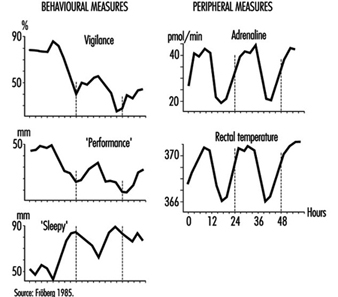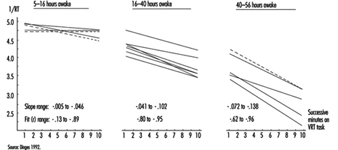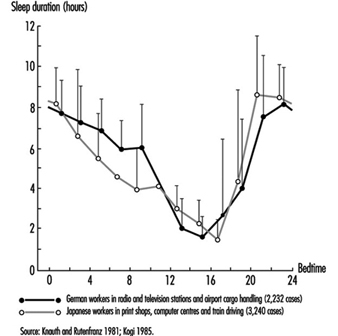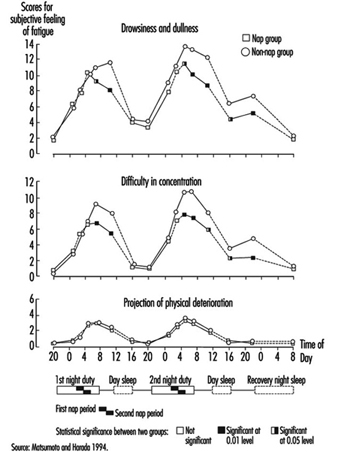Healthy individuals regularly sleep for several hours every day. Normally they sleep during the night hours. They find it most difficult to remain awake during the hours between midnight and early morning, when they normally sleep. If an individual has to remain awake during these hours either totally or partially, the individual comes to a state of forced sleep loss, or sleep deprivation, that is usually perceived as tiredness. A need for sleep, with fluctuating degrees of sleepiness, is felt which continues until sufficient sleep is taken. This is the reason why periods of sleep deprivation are often said to cause a person to incur sleep deficit or sleep debt.
Sleep deprivation presents a particular problem for workers who cannot take sufficient sleep periods because of work schedules (e.g., working at night) or, for that matter, prolonged free-time activities. A worker on a night shift remains sleep-deprived until the opportunity for a sleep period becomes available at the end of the shift. Since sleep taken during daytime hours is usually shorter than needed, the worker cannot recover from the condition of sleep loss sufficiently until a long sleep period, most likely a night sleep, is taken. Until then, the person accumulates a sleep deficit. (A similar condition—jet lag—arises after travelling between time zones that differ by a few hours or more. The traveller tends to be sleep-deprived as the activity periods in the new time zone correspond more clearly to the normal sleep period in the originating place.) During the periods of sleep loss, workers feel tired and their performance is affected in various ways. Thus various degrees of sleep deprivation are incorporated into the daily life of workers having to work irregular hours and it is important to take measures to cope with unfavourable effects of such sleep deficit. The main conditions of irregular working hours that contribute to sleep deprivation are shown in table 1.
Table 1. Main conditions of irregular working hours which contribute to sleep deprivation of various degrees
|
Irregular working hours |
Conditions leading to sleep deprivation |
|
Night duty |
No or shortened night-time sleep |
|
Early morning or late evening duty |
Shortened sleep, disrupted sleep |
|
Long hours of work or working two shifts together |
Phase displacement of sleep |
|
Straight night or early morning shifts |
Consecutive phase displacement of sleep |
|
Short between-shift period |
Short and disrupted sleep |
|
Long interval between days off |
Accumulation of sleep shortages |
|
Work in a different time zone |
No or shortened sleep during the “night” hours in the originating place (jet lag) |
|
Unbalanced free time periods |
Phase displacement of sleep, short sleep |
In extreme conditions, sleep deprivation may last for more than a day. Then sleepiness and performance changes increase as the period of sleep deprivation is prolonged. Workers, however, normally take some form of sleep before sleep deprivation becomes too protracted. If the sleep thus taken is not sufficient, the effects of sleep shortage still continue. Thus, it is important to know not only the effects of sleep deprivation in various forms but also the ways in which workers can recover from it.
Figure 1. Perfomance, sleep ratings and physiological variables of a group of subjects exposed to two nights of sleep deprivation
The complex nature of sleep deprivation is shown by figure 1, which depicts data from laboratory studies on the effects of two days of sleep deprivation (Fröberg 1985). The data show three basic changes resulting from prolonged sleep deprivation:
- There is a general decreasing trend in both objective performance and subjective ratings of performance efficiency.
- The decline in performance is influenced by the time of day. This cycling decline is correlated with those physiological variables which have a circadian cycling period. Performance is better in the normal activity phase when, for example, adrenaline excretion and body temperature are higher than those in the period originally assigned to a normal night’s sleep, when the physiological measures are low.
- Self-ratings of sleepiness increase with time of continuous sleep deprivation, with a clear cyclic component associated with time of day.
The fact that the effects of sleep deprivation are correlated with physiological circadian rhythms helps us to understand its complex nature (Folkard and Akerstedt 1992). These effects should be viewed as a result of a phase shift of the sleep-wakefulness cycle in one’s daily life.
The effects of continuous work or sleep deprivation thus include not only a reduction in alertness but decreased performance capabilities, increased probability of falling asleep, lowered well-being and morale and impaired safety. When such periods of sleep deprivation are repeated, as in the case of shift workers, their health may be affected (Rutenfranz 1982; Koller 1983; Costa et al. 1990). An important aim of research is thus to determine to what extent sleep deprivation damages the well-being of individuals and how we can best use the recovery function of sleep in reducing such effects.
Effects of Sleep Deprivation
During and after a night of sleep deprivation, the physiological circadian rhythms of the human body seem to remain sustained. For example, the body temperature curve during the first day’s work among night-shift workers tends to keep its basic circadian pattern. During the night hours, the temperature declines towards early morning hours, rebounds to rise during the subsequent daytime and falls again after an afternoon peak. The physiological rhythms are known to get “adjusted” to the reversed sleep-wakefulness cycles of night-shift workers only gradually in the course of several days of repeated night shifts. This means that the effects on performance and sleepiness are more significant during night hours than in the daytime. The effects of sleep deprivation are therefore variably associated with the original circadian rhythms seen in physiological and psychological functions.
The effects of sleep deprivation on performance depend on the type of the task to be performed. Different characteristics of the task influence the effects (Fröberg 1985; Folkard and Monk 1985; Folkard and Akerstedt 1992). Generally, a complex task is more vulnerable than a simpler task. Performance of a task involving an increasing number of digits or a more complex coding deteriorates more during three days of sleep loss (Fröberg 1985; Wilkinson 1964). Paced tasks that need to be responded to within a certain interval deteriorate more than self-paced tasks. Practical examples of vulnerable tasks include serial reactions to defined stimulations, simple sorting operations, the recording of coded messages, copy typing, display monitoring and continuous inspection. Effects of sleep deprivation on strenuous physical performance are also known. Typical effects of prolonged sleep deprivation on performance (on a visual task) is shown in figure 2 (Dinges 1992). The effects are more pronounced after two nights of sleep loss (40-56 hours) than after one night of sleep loss (16-40 hours).
Figure 2. Regression lines fit to response speed (the reciprocal of response times) on a 10-minute simple, unprepared visual task administered repeatedly to healthy young adults during no sleep loss (5-16 hours), one night of sleep loss (16-40 hours) and two nights of sleep loss (40-56 hours)
The degree to which the performance of tasks is affected also appears to depend on how it is influenced by the “masking” components of the circadian rhythms. For example, some measures of performance, such as five-target memory search tasks, are found to adjust to night work considerably more quickly than serial reaction time tasks, and hence they may be relatively unimpaired on rapidly rotating shift systems (Folkard et al. 1993). Such differences in the effects of endogenous physiological body clock rhythms and their masking components must be taken into account in considering the safety and accuracy of performance under the influence of sleep deprivation.
One particular effect of sleep deprivation on performance efficiency is the appearance of frequent “lapses” or periods of no response (Wilkinson 1964; Empson 1993). These performance lapses are short periods of lowered alertness or light sleep. This can be traced in records of videotaped performance, eye movements or electroencephalograms (EEGs). A prolonged task (one-half hour or more), especially when the task is replicated, can more easily lead to such lapses. Monotonous tasks such as repetitions of simple reactions or monitoring of infrequent signals are very sensitive in this regard. On the other hand, a novel task is less affected. Performance in changing work situations is also resistant.
While there is evidence of a gradual arousal decrease in sleep deprivation, one would expect less affected performance levels between lapses. This explains why results of some performance tests show little influence of sleep loss when the tests are done in a short period of time. In a simple reaction time task, lapses would lead to very long response times whereas the rest of the measured times would remain unchanged. Caution is thus needed in interpreting test results concerning sleep loss effects in actual situations.
Changes in sleepiness during sleep deprivation obviously relate to physiological circadian rhythms as well as to such lapse periods. Sleepiness sharply increases with time of the first period of night-shift work, but decreases during subsequent daytime hours. If sleep deprivation continues to the second night sleepiness becomes very advanced during the night hours (Costa et al. 1990; Matsumoto and Harada 1994). There are moments when the need for sleep is felt to be almost irresistible; these moments correspond to the appearance of lapses, as well as to the appearance of interruptions in the cerebral functions as evidenced by EEG records. After a while, sleepiness is felt to be reduced, but there follows another period of lapse effects. If workers are questioned about various fatigue feelings, however, they usually mention increasing levels of fatigue and general tiredness persisting throughout the sleep deprivation period and between-lapse periods. A slight recovery of subjective fatigue levels is seen during the daytime following a night of sleep deprivation, but fatigue feelings are remarkably advanced in the second and subsequent nights of continued sleep deprivation.
During sleep deprivation, sleep pressure from the interaction of prior wakefulness and circadian phase may always be present to some degree, but the lability of state in sleepy subjects is also modulated by context effects (Dinges 1992). Sleepiness is influenced by the amount and type of stimulation, the interest afforded by the environment and the meaning of the stimulation to the subject. Monotonous stimulation or that requiring sustained attention can more easily lead to vigilance decrement and lapses. The greater the physiological sleepiness due to sleep loss, the more the subject is vulnerable to environmental monotony. Motivation and incentive can help override this environmental effect, but only for a limited period.
Effects of Partial Sleep Deprivation and Accumulated Sleep Shortages
If a subject works continuously for a whole night without sleep, many performance functions will have definitely deteriorated. If the subject goes to the second night shift without getting any sleep, the performance decline is far advanced. After the third or fourth night of total sleep deprivation, very few people can stay awake and perform tasks even if highly motivated. In actual life, however, such conditions of total sleep loss rarely occur. Usually people take some sleep during subsequent night shifts. But reports from various countries show that sleep taken during daytime is almost always insufficient to recover from the sleep debt incurred by night work (Knauth and Rutenfranz 1981; Kogi 1981; ILO 1990). As a result, sleep shortages accumulate as shift workers repeat night shifts. Similar sleep shortages also result when sleep periods are reduced on account of the need to follow shift schedules. Even if night sleep can be taken, sleep restriction of as little as two hours each night is known to lead to an insufficient amount of sleep for most persons. Such sleep reduction can lead to impaired performance and alertness (Monk 1991).
Examples of conditions in shift systems which contribute to accumulation of sleep shortages, or partial sleep deprivation, are given in table 1. In addition to continued night work for two or more days, short between-shift periods, repetition of an early start of morning shifts, frequent night shifts and inappropriate holiday allotment accelerate the accumulation of sleep shortages.
The poor quality of daytime sleep or shortened sleep is important, too. Daytime sleep is accompanied by an increased frequency of awakenings, less deep and slow-wave sleep and a distribution of REM sleep different from that of normal night-time sleep (Torsvall, Akerstedt and Gillberg 1981; Folkard and Monk 1985; Empson 1993). Thus a daytime sleep may not be as sound as a night sleep even in a favourable environment.
This difficulty of taking good quality sleep due to different timing of sleep in a shift system is illustrated by figure 3 which shows the duration of sleep as a function of the time of sleep onset for German and Japanese workers based on diary records (Knauth and Rutenfranz 1981; Kogi 1985). Due to circadian influence, daytime sleep is forced to be short. Many workers may have split sleep during the daytime and often add some sleep in the evening where possible.
Figure 3. Mean sleep length as a function of the time of sleep onset. Comparison of data from German and Japanese shift workers.
In real-life settings, shift workers take a variety of measures to cope with such accumulation of sleep shortages (Wedderburn 1991). For example, many of them try to sleep in advance before a night shift or have a long sleep after it. Although such efforts are by no means entirely effective to offset the effects of sleep deficit, they are made quite deliberately. Social and cultural activities may be restricted as part of coping measures. Outgoing free-time activities, for example, are undertaken less frequently between two night shifts. Sleep timing and duration as well as the actual accumulation of sleep deficit thus depend on both job-related and social circumstances.
Recovery from Sleep Deprivation and Health Measures
The only effective means of recovering from sleep deprivation is to sleep. This restorative effect of sleep is well known (Kogi 1982). As recovery by sleep may differ according to its timing and duration (Costa et al. 1990), it is essential to know when and for how long people should sleep. In normal daily life, it is always the best to take a full night’s sleep to accelerate the recovery from sleep deficit but efforts are usually made to minimize sleep deficit by taking sleep at different occasions as replacements of normal night sleeps of which one has been deprived. Aspects of such replacement sleeps are shown in table 2.
Table 2. Aspects of advance, anchor & retard sleeps taken as replacement of normal night sleep
|
Aspect |
Advance sleep |
Anchor sleep |
Retard sleep |
|
Occasion |
Before a night shift |
Intermittent night |
After a night shift |
|
Duration |
Usually short |
Short by definition |
Usually short but |
|
Quality |
Longer latency of |
Short latency |
Shorter latency for |
|
Interaction with |
Disrupted rhythms; |
Conducive to |
Disrupted rhythms; |
To offset night sleep deficit, the usual effort made is to take daytime sleep in “advance” and “retard” phases (i.e., before and after night-shift work). Such a sleep coincides with the circadian activity phase. Thus the sleep is characterized by longer latency, shortened slow-wave sleep, disrupted REM sleep and disturbances of one’s social life. Social and environmental factors are important in determining the recuperative effect of a sleep. That a complete conversion of circadian rhythms is impossible for a shift worker in a real-life situation should be borne in mind in considering the effectiveness of the recovery functions of sleep.
In this respect, interesting features of a short “anchor sleep” have been reported (Minors and Waterhouse 1981; Kogi 1982; Matsumoto and Harada 1994). When part of the customary daily sleep is taken during the normal night sleep period and the rest at irregular times, the circadian rhythms of rectal temperature and urinary secretion of several electrolytes can retain a 24-hour period. This means that a short night-time sleep taken during the night sleep period can help preserve the original circadian rhythms in subsequent periods.
We may assume that sleeps taken at different periods of the day could have certain complementary effects in view of the different recovery functions of these sleeps. An interesting approach for night-shift workers is the use of a night-time nap which usually lasts up to a few hours. Surveys show this short sleep taken during a night shift is common among some groups of workers. This anchor-sleep type sleep is effective in reducing night work fatigue (Kogi 1982) and may reduce the need of recovery sleep. Figure 4 compares the subjective feelings of fatigue during two consecutive night shifts and the off-duty recovery period between the nap-taking group and the non-nap group (Matsumoto and Harada 1994). The positive effects of a night-time nap in reducing fatigue was obvious. These effects continued for a large part of the recovery period following night work. Between these two groups, no significant difference was found upon comparing the length of the day sleep of the non-nap group with the total sleeping time (night-time nap plus subsequent day sleep) of the nap group. Therefore a night-time nap enables part of the essential sleep to be taken in advance of the day sleep following night work. It can therefore be suggested that naps taken during night work can to a certain extent aid recovery from the fatigue caused by that work and accompanying sleep deprivation (Sakai et al. 1984; Saito and Matsumoto 1988).
Figure 4. Mean scores for subjective feelings of fatigue during two consecutive night shifts and the off-duty recovery period for nap and no-nap groups
It must be admitted, however, that it is not possible to work out optimal strategies that each worker suffering from sleep deficit can apply. This is demonstrated in the development of international labour standards for night work that recommend a set of measures for workers doing frequent night work (Kogi and Thurman 1993). The varied nature of these measures and the trend towards increasing flexibility in shift systems clearly reflect an effort to develop flexible sleep strategies (Kogi 1991). Age, physical fitness, sleep habits and other individual differences in tolerance may play important roles (Folkard and Monk 1985; Costa et al. 1990; Härmä 1993). Increasing flexibility in work schedules in combination with better job design is useful in this regard (Kogi 1991).
Sleep strategies against sleep deprivation should be dependent on type of working life and be flexible enough to meet individual situations (Knauth, Rohmert and Rutenfranz 1979; Rutenfranz, Knauth and Angersbach 1981; Wedderburn 1991; Monk 1991). A general conclusion is that we should minimize night sleep deprivation by selecting appropriate work schedules and facilitate recovery by encouraging individually suitable sleeps, including replacement sleeps and a sound night-time sleep in the early periods after sleep deprivation. It is important to prevent the accumulation of sleep deficit. The period of night work which deprives workers of sleep in the normal night sleep period should be as short as possible. Between-shift intervals should be long enough to allow a sleep of sufficient length. A better sleep environment and measures to cope with social needs are also useful. Thus, social support is essential in designing working time arrangements, job design and individual coping strategies in promoting the health of workers faced with frequent sleep deficit.



